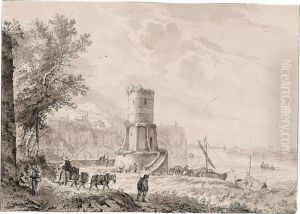Arie Lamme Paintings
Arie Lamme was a Dutch artist, born in the year 1812, in Dordrecht, Netherlands. He became known for his contributions to the Dutch art world during the 19th century, primarily as a landscape painter, watercolorist, and engraver. His works often depicted the serene and picturesque landscapes of the Netherlands, capturing the essence of Dutch rural and urban scenes with a keen eye for detail and a profound sense of atmospherics. Lamme's artistic journey was deeply influenced by the Dutch landscape tradition, following in the footsteps of earlier masters who celebrated the beauty of the Dutch environment.
Throughout his career, Lamme developed a distinctive style that highlighted the interplay of light and shadow, a technique that added a lyrical quality to his landscapes. His ability to capture the varying moods of the environment, from the tranquil to the tempestuous, earned him a reputable place among his contemporaries. Despite facing the challenges of the evolving art market and the shifting tastes of the 19th-century art audience, Lamme continued to dedicate himself to his craft, exploring different mediums and techniques.
In addition to his landscapes, Lamme was also known for his engravings, which showcased his meticulous attention to detail and his mastery of the medium. These works often featured architectural and historical subjects, reflecting his interest in the heritage and history of his homeland. His contributions to the field of engraving are notable for their precision and clarity, making them valuable records of the era's aesthetic and cultural values.
Lamme's works were exhibited in various art shows and galleries throughout his lifetime, allowing him to gain recognition and respect from both critics and the public. Despite the fact that he is not as widely known today as some of his contemporaries, his art continues to be appreciated by collectors and historians for its beauty and historical significance. Arie Lamme passed away in the year 1900, leaving behind a legacy that continues to celebrate the Dutch landscape and its enduring allure. His dedication to his art and his ability to capture the essence of his surroundings make him a noteworthy figure in the history of Dutch painting.
